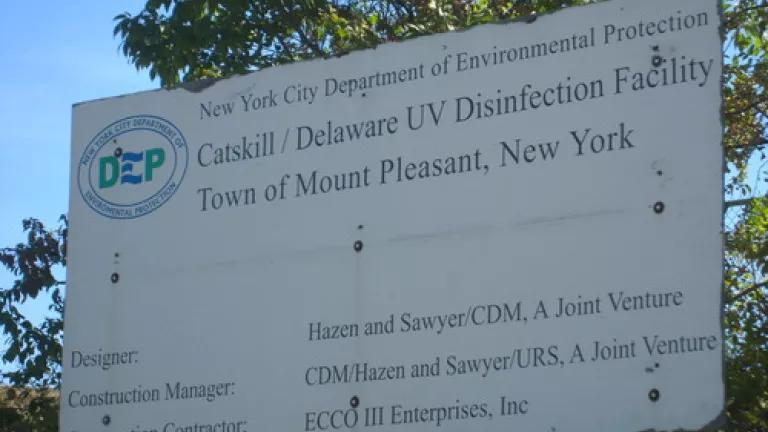New York City Opens New Ultra-Violet Drinking Water Disinfection Plant - the World's Largest

New York City added a new protective shield to its drinking water supply infrastructure today, as City Environmental Protection Commissioner Carter Strickland cut the ribbon on a $1.6 billion dollar ultra-violet disinfection plant on city-owned land in Westchester County
The new plant is designed to offer another level of protection for water from New York City’s Catskill and Delaware systems reservoirs, which supply drinking water to more than 9 million New Yorkers – nearly half the state’s population.
The facility, which is located within the Towns of Mount Pleasant and Greenburgh, is being operated by the New York City Department of Environmental Protection, the agency that provides drinking water to the nation’s largest city and portions of Westchester County.
On a typical day, the UV plant is expected to treat between 800 and 1400 million gallons of water funneled into it from the City’s nearby Kensico Reservoir. Its maximum design flow is 2 billion gallons a day; according to city officials, no other similar facility in the world is anywhere near as large.
In the disinfection process, water from the city’s Catskill and Delaware system aqueducts will flow through one of 56 giant units that will expose the liquid to ultra-violet light. The ultra-violet treatment interferes with the ability of microbial contaminants like cryptosporidium and giardia to reproduce. This UV technology, which has long been used in wastewater disinfection settings, doesn’t affect taste or otherwise pose a risk to the public. The UV disinfection treatment will supplement the city’s other water protection programs, including chlorination and watershed protection, which have for years provided city water drinkers with high quality drinking water that meets federal Safe Drinking Water Act requirements.
Today, New York City is officially opening what is, according to city officials, the largest ultra-violet drinking water disinfection plant in the world. The plant is a symbol of successful implementation of the federal Safe Drinking Water Act; it should help assure long-term protection of the high quality Catskill and Delaware water supplies, which serve nine million New Yorkers, at a fraction of the cost of more traditional water filtration infrastructure.
Today’s official opening caps a one-year testing and phase-in period and a decade-long planning, design and construction effort that employed over 800 workers at its peak.
The plant’s construction was undertaken pursuant to the federal Safe Drinking Water Act and its implementing regulations. These directives provide that all surface water suppliers seeking to avoid the construction of costly and energy-intensive filtration facilities must meet stringent water quality standards and implement various pollution-prevention and water quality programs.
In the 1990s, it was projected that filtration facilities for the Catskill and Delaware system would have cost ten billion dollars or more just in capital dollars. That cost was among the reasons why city officials and environmental groups joined together to support watershed protection and other cost-effective alternative strategies for safeguarding New York City’s high quality Catskill and Delaware water supplies.
In 2001, the U.S. Environmental Protection Agency, in agreeing to approve such filtration alternatives for New York, directed the city to design and construct an ultra-violet disinfection plant as part of its filtration avoidance program. (New York is one of only five major cities that has secured a waiver from the Safe Drinking Water Act’s filtration requirement. The others are Seattle, Portland, San Francisco and Boston. Seattle opened its own ultra-violet disinfection plant to safeguard its high quality unfiltered water supply in 2004.)
It would be a mistake to take New York's abundant, high quality drinking water supply for granted. Across the nation, every state west of the Mississippi has experienced at least some level of drought conditions this year; California has suffered its driest year on record. Around the world, nearly a billion people do not have access to clean and safe water. And, by 2025, according to one estimate from the United Nations, as many as 1.8 billion people will be living in countries or regions “with absolute water scarcity.”
Fortunately, New York’s watershed region continues to receive close to 50 inches a year of rain; the short-term drinking water outlook here is positive. But climate change and the unpredictable changes in weather patterns that it is bringing represent a long-term risk to water quality in New York. And there are other threats to our priceless and irreplaceable water supply. Among them are pollution and threats to the integrity of our aqueducts from planned hydraulic fracturing (“fracking”) in the Marcellus Shale and runoff that would likely result from the proposed development of multiple Las-Vegas style casinos in the Catskills.
Still, today’s official opening of New York City’s ultra-violet disinfection facility is cause for celebration. This facility should help safeguard the quality of the downstate water supply for decades, while staving off the need for a much costlier and more energy-intensive water filtration plant.
If New Yorkers were more familiar with the efforts that city, state and federal agencies made to advance this facility and insure the safety of our drinking water supply, they wouldn’t waste a drop.

Above, the plant during final construction and testing last year.

